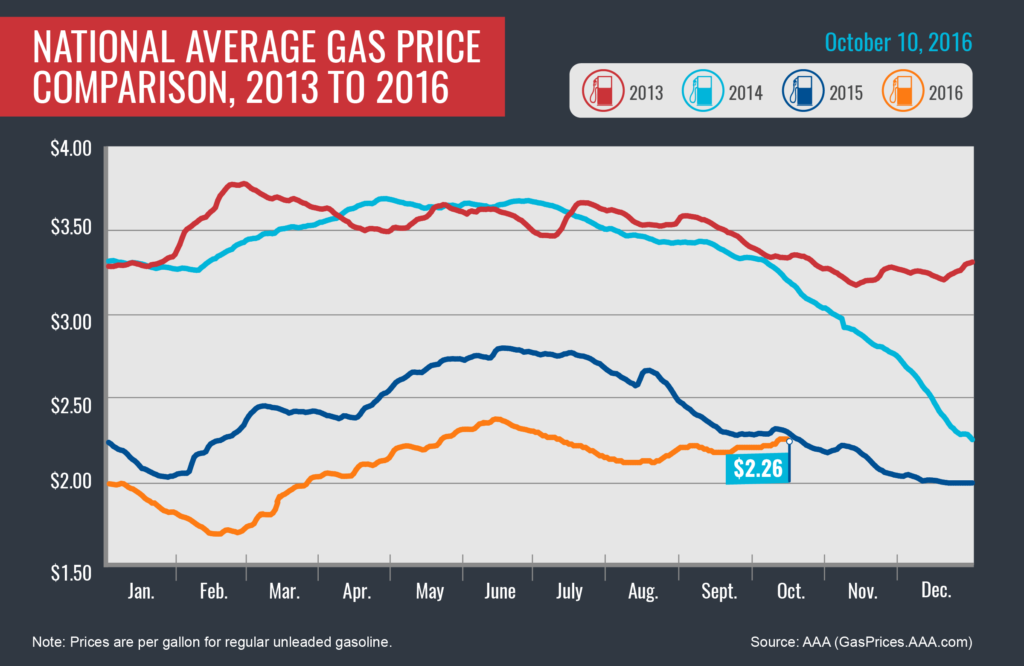The national average price for regular unleaded gasoline has increased for 12 of the past 14 days, reaching today’s price of $2.26 per gallon. Today’s average price is 3 cents more than one week ago, 8 cents more than one month ago and 6 cents less than one year ago.

Over the weekend, Florida, Georgia and South Carolina saw the arrival of Hurricane Matthew and residents in those areas expressed significant concerns about the availability of gasoline leading up to and following the storm. Ports and fuel terminals in all three states were closed ahead of the storm. Fortunately, there were no refineries threatened by the path of the storm and by Friday afternoon many ports in southern Florida were already cleared by the Coast Guard and open to receive vessels.
Many coastal ports are expected to reopen on Monday, allowing waterborne deliveries of gasoline to continue. Barring any delays due to flooding and power outages, tanker trucks should be able to access terminals and quickly resupply stations across the impacted areas.
Quick Stats
- The West Coast continues to be the most expensive market for gasoline, including the only six states where drivers are paying $2.50 or more on average: Hawaii ($2.84), California ($2.79) Washington ($2.72), Alaska ($2.64), Oregon ($2.52) and Nevada ($2.50).
- The states with the largest increases this week are Indiana (+11 cents), Michigan (+10 cents), Missouri (+8 cents), West Virginia (+8 cents), Ohio (+8 cents), Illinois (+6 cents) and Florida (+6 cents).

West Coast
The West Coast features the highest prices in the nation as has consistently been the case over the past decade. However, drivers in these same states are also among the only motorists who have seen prices remain steady over the past week. Alaska ($2.63), Washington ($2.71), California ($2.79), Nevada ($2.50) and Oregon ($2.52) all land on the list of smallest weekly changes. The West Coast transition to winter specification gasoline will take place in about two weeks. Supply in the region is already being impacted as many refiners begin maintenance for the switch, including some very large-scale turnaround work at Chevron’s Richmond, Calif., refinery.
Rockies
Prices in the Rocky Mountains remain relatively stable compared to other markets. This is primarily due to limited disruptions to regional production in the past months and their geographic location in the center of the country, which helps to insulate the region from coastal price swings. Barring any unforeseen production issues, drivers should see prices continue to move lower as we move into the winter driving season.
Great Lakes and Central States
Pump prices in the Great Lakes region saw significant increases over the past week. Regional prices remain impacted by two factors – seasonal refinery work at key plants like BP’s 430,000-b/d Whiting refinery and replenishment of inventory lost last month, when product had to be moved from Ohio, Indiana and Illinois to assist states in the Southeast impacted by problems on the Colonial Pipeline. While prices in recent weeks have been a mixed bag of increases and decreases, regional prices over the past week have moved universally higher, with five Midwestern states making the list of top increases: Indiana (+11 cents), Michigan (+10 cents), Missouri (+8 cents), Ohio (+8 cents), Illinois (+6 cents).
The Central United States has some of the cheapest prices in the country, although prices have followed the national average higher over the past week. Four states in the region feature in the top-15 lowest: Arkansas ($2.05), Missouri ($2.07), Oklahoma ($2.07) and Tennessee ($2.14).

Mid-Atlantic and Northeast
While still largely cheaper than one month ago, prices in the Mid-Atlantic and Northeast have moved higher over the past week which can likely be attributed to Hurricane Matthew’s impact on the Southeast region. Increases have been most evident in the Mid-Atlantic, where two states and D.C. made the list of top-15 largest weekly increases: District of Columbia (+5 cents), New Jersey (+4 cents), and Pennsylvania (+4 cents).
South and Southeast
Hurricane Matthew caused prices to jump in some parts of the region, with Florida (+6 cents) and North Carolina (+4 cents) both landing on the list of top-15 weekly increases. The Hurricane caused supply issues at many gas stations last week as evacuation notices resulted in closed ports and terminals. Without access to local terminals, many gas stations could not handle the high demand of drivers preparing for the hurricane. Despite the issues, gasoline supplies in the Southeast region remain plentiful. Hurricane Matthew was expected to have much more impact on demand and less on supply. On Friday afternoon, ports in Miami, Key West and Port Canaveral were already reopened to vessel traffic. Barring any delays due to flooding and power outages, tanker trucks should be able to access terminals and resupply stations across the impacted areas.
Refiners in the Gulf Coast are preparing to meet fall demand but reports from OPIS indicate that refineries in Big Spring and Pasadena, Texas had maintenance issues last week which impacted supplies and caused increases in some states.
Oil Market Dynamics
Attention is now focused on whether the Organization of Petroleum Exporting Countries (OPEC) will alter production in order to influence prices higher. OPEC members are scheduled to have a number of meetings before the end of November in order to identify the details of an output agreement, which has supported the bearish sentiment for crude oil over the past week. Traders will keep a close eye on OPEC negotiations moving forward and will be on the lookout for an oil production framework. At the close of Friday’s formal trading session on the NYMEX, WTI was down 63 cents to settle at $49.81 per barrel.
Motorists can find current gas prices along their route with the free AAA Mobile app for iPhone, iPad and Android. The app can also be used to map a route, find discounts, book a hotel and access AAA roadside assistance. Learn more at AAA.com/mobile.
